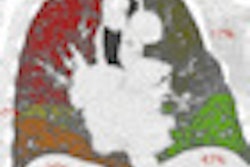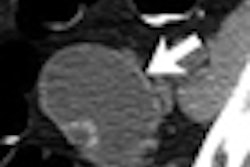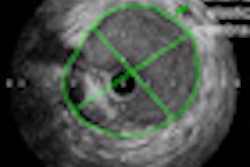The use of advanced imaging to scan patients admitted to emergency departments grew dramatically between 1998 and 2007, driven by growth in CT. The rise occurred despite little change in the severity or number of injuries in emergency patients, according to a new study in the Journal of the American Medical Association.
Patients at the end of the study period were more than three times as likely to receive an advanced imaging scan when admitted to emergency departments compared to those at the beginning of the study, according to a research group led by Frederick Korley, MD, from Baltimore's Johns Hopkins University (JAMA, October 6, 2010, Vol. 304:14, pp. 1465-1471).
The higher imaging rates have numerous health policy implications, ranging from the increased cost burden that imaging puts on the healthcare system to the health risks that could develop from imaging exams, such as radiation-induced cancer from CT. The issue is particularly relevant for younger individuals, as some 70% of injury-related hospital visits are for those younger than 45.
"This group is at the greatest risk for potential long-term oncological effects of ionizing radiation exposure," Korley and colleagues wrote.
Nationwide annual survey
For their retrospective study, the researchers examined national trends in the use of advanced imaging -- including both CT and MRI -- during emergency department visits for injury-related conditions over a 10-year period (1998-2007).
Hypothesizing that advanced imaging rates had increased over the study period, the authors aimed to determine whether there had been a change in the prevalence of emergency department visits for injury-related conditions for which CT or MRI was used -- and whether there had been a change in the diagnosis of life-threatening conditions and patient disposition.
A secondary question for the study included the proportion of visits during which a life-threatening condition was diagnosed, including skull fracture, cervical spine fracture, intracranial hemorrhage, or liver or spleen lacerations.
"We chose these diagnoses because they are the most common life-threatening injury-related conditions that are diagnosed using CT," the authors wrote.
Korley and colleagues relied on data from the National Hospital Ambulatory Medical Care Survey, a national probability-based sample of visits to emergency departments and outpatient departments of noninstitutional general and short-stay hospitals located in all 50 states. The annual survey uses probability sampling to collect data on the use and provision of ambulatory care services.
The visits sampled for the study -- 324,569 emergency department visits between 1998 and 2007 -- included 65,376 patients presenting with injury-related conditions (20%), representing an estimated average of 22.4 million visits made to emergency departments in the U.S. each year for injury-related conditions. The visits were sampled from an average of 370 hospitals per year.
The data showed that CT or MRI use had nearly tripled during emergency department visits for injury-related conditions between 1998 and 2007.
The prevalence of injury-related CT or MR use increased from 257 exams in 5,237 visits in 1998, or 6% of all visits (95% confidence interval [CI]: 5%-7%), to 981 imaging studies in 6,567 visits in 2007, or 15% of all visits (95% CI: 14%-17%) (p < 0.001 for trend).
There was a small increase in the prevalence of life-threatening conditions, from 1.7% (95% CI: 1.2%-2.2%) in 1998 to 2.0% (95% CI: 1.6%-2.5%) in 2007 (p = 0.04 for trend). The trends were not significantly affected by confounders such as age, insurance status, pain, and immediacy with which a patient should be seen. Nevertheless, patients were more likely to be scanned in the later study periods.
Imaging use rises
Compared with patients who presented to emergency departments for injury-related conditions in 1998, those who presented to emergency departments for injury-related conditions in 2007 were significantly more likely to receive CT or MRI, with an adjusted odds ratio (AOR) of 3.43 (95% CI: 2.71-4.35), wrote Korley, along with his co-authors Julius Cuong Pham, MD, PhD, and Thomas Dean Kirsch, MD.
Even as advanced imaging rates rose, however, hospital admissions remained stable -- showing an insignificant drop from 5.9% [95% CI: 4.9%-6.9%] in 1998 to 5.5% [95% CI: 4.7%-6.5%] in 2007.
There was no significant change in the proportion of injury-related visits that resulted in admission to the hospital. But care did take longer when imaging was included. Visits during which CT or MRI was obtained lasted 126 minutes longer (95% CI: 123-131 minutes) than those when the imaging modalities were not used, the group noted.
Growth rates in the use of imaging were lower in the pediatric population than any other age group, where prevalence of CT or MRI use doubled rather than tripled during the study period.
Pain appeared to have played a role in imaging decisions. Patients with severe pain were more likely than those with mild pain to receive CT or MRI. There was also a higher likelihood for patients presenting to academic emergency departments to receive CT or MRI than those presenting to nonacademic emergency departments (OR, 1.55 [95% CI: 1.28-1.88]; AOR, 1.52 [95% CI: 1.22-1.90]).
It wasn't MRI causing the change; rather, increases in CT use accounted for the majority of the increased use of advanced imaging, the authors wrote. A prior study demonstrated increases in CT use for patients with abdominal pain without any increase in the rate of diagnosis of significant intra-abdominal conditions.
Why imaging happens
Factors that may have contributed to the rise in CT use include:
- The modality's superiority over x-rays for diagnosing conditions such as cervical spine fractures
- The routine use of whole-body CT scanning for patients treated in some trauma centers
- The increased availability of CT scanners
- The proximity of CT scanners to patient care areas of most emergency departments
- The faster speed of newer CT scanners leading to a decrease in the need to sedate pediatric patients
- Concern about malpractice lawsuits for a missed diagnosis
Other studies have blamed increasing utilization of imaging on patient demand, the growth in direct-to-consumer marketing, the increasing use of imaging in nonemergency department settings, and "the ability of physicians to refer patients to their own practices for imaging," Korley and colleagues wrote.
According to the U.S. Government Accountability Office (GAO), annual spending on CT imaging more than doubled from 2000 to 2007, from $975 million to $2.2 billion. During the same period, spending for standard imaging (plain radiographs and ultrasound) increased by 65%.
Limitations of the study included its use of a probabilistic sampling method and its retrospective nature, as well as the authors' inability to examine and adjust the results depending on disease severity. It must also be noted that many efforts now in place to curb the overuse of imaging began after 2007.
There was no increase in the number of injuries or severity of disease over the study period to explain a threefold rise in advanced imaging use between 1998 and 2007, the authors concluded.
"Further work is needed to understand the patient, hospital, and physician factors responsible for this increase and to optimize the risk-benefit balance of advanced radiology use," they wrote. "The role of evidence-adoption strategies such as computerized decision support and audit and feedback in promoting adherence to decision rules for imaging needs to be further understood."
By Eric Barnes
AuntMinnie.com staff writer
October 5, 2010
Related Reading
Repeat imaging in kids with cancer: a balancing act, September 28, 2010
Radiologists call for curbs on overuse of imaging, August 24, 2010
CMS unveils imaging decision-support initiative, July 23, 2010
One-quarter of outpatient CT and MRI exams are inappropriate, March 1, 2010
CDC report: MRI, CT, PET use spikes in physician offices, ER, February 18, 2010
Copyright © 2010 AuntMinnie.com



















